接地、接地和接合之间的区别
Earth、Grounding 和 Bonding 有什么区别?
在理解接地、接地和连接之间的基本概念和主要区别时存在异常混乱,甚至一些专业人士将接地、接地和连接的词互换,例如接地连接、接地连接等等。此外,电气连接是完全不同于接地和接地的东西。
直言不讳,Grounding 和 Earthing 是同一个概念,用不同的术语表示。接地和接地之间有一个小的区别,我们将在下面详细讨论。
- “接地”一词与美国和加拿大的“接地”一词相同 基于NEC , CEC , IEEE , UL &ANSI 标准 .
- Earthing 一词用于欧盟、英国 和其他遵循 IEC 的国家 和信息系统标准 .
- 在美国、英国和欧盟(NEC 和 IEC)中,接合或电气接合一词用于连接和接合两个导体(电线、泵、机器、管道等)和金属体(在正常情况下不带电)操作)永久平衡通过键合线连接的两台机器或系统上的电位差。
简而言之,接地和接地是在美国和英国使用的本地版本术语。例如,保护接地“PG ”在美国使用,而保护接地“PE ”用于英国和欧共体。同样,地电位上升 “雷达 ”或地势上升 “EPR ”分别在美国和英国使用。换句话说,“双向开关”和“三向开关”这两个词在美国和英国分别用于相同用途的同一事物。
- 相关文章:电气接地 - 接地和接地的方法和类型
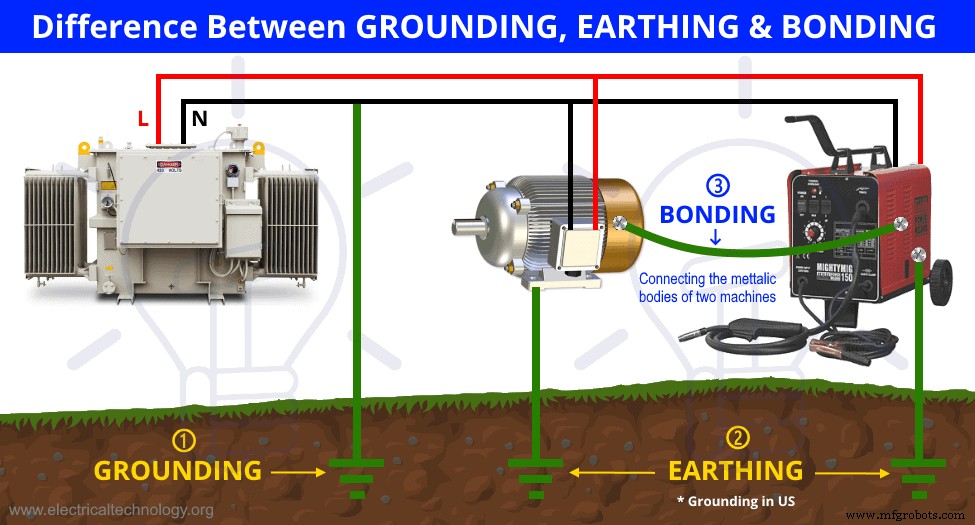
现在让我们一一详细讨论。
什么是接地?
接地是机器的带电部件(在正常运行中承载电流)与大地之间的连接,例如发电机的中性点或星形连接的中性点电源变压器。 这种接地提供了从设备到电源的故障电流的有效路径,从而保护电力系统装置和设备。
接地也用于平衡不平衡系统。例如,当系统发生故障时,所有三相(线)都变得不平衡,因此,接地将故障电流释放到大地,使系统再次平衡,使总中性线电流为“0”(这是不可能的)在特定情况下获得这个值,但它会减少到几乎理想的情况,即最接近的值)。
此外,接地提供了对浪涌电压(闪电、线路故障和浪涌)的保护,并将过电压释放到地面,从而使系统稳定可靠,最大限度地提高变压器效率.
- 电气和电子工程中的交流和直流电路都需要一个“0V”作为参考电位,称为接地,这使得电流能够从生成的电源流向负载侧。
- 并非必须始终将地线连接到大地,例如在车辆和汽车中,地线与金属车身和底盘相连,金属车身和底盘通过橡胶轮胎进一步与大地绝缘。接地在配电系统中的用户端或配电点接地。
- 没有必要将零线接地,因为由于电线或其他系统中使用的这两条线的电压降,可能存在零线对地电压。
小知识:
- Grounding 可以作为 Neutral,但是 Neutral 不能作为 ground。因此,切勿将中性线两次接地(即中性线应在发电站或电线杆中的用户单元或配电变压器的末端接地(接地)。
- 多个接地会给 OCPD(过流保护装置)的正常操作带来问题,因为电流量不足以操作这些保护装置。在某些情况下,未接地的 WYE 电路(设备的保护接地仍然连接)用于防止 OCPD 运行(单相接地故障)。
- GFCI(接地故障断路器)是一种保护装置,用于检测热(未接地)和中性(接地)导体之间的电流不平衡情况,以防万一保护生命(不建议在医院 ICU 和其他需要连续不间断电源的敏感区域使用这些保护装置。了解有关 GFCI 和 AFCI 布线安装的更多信息。
相关文章:如何确定接地导体、接地引线和接地电极的尺寸?
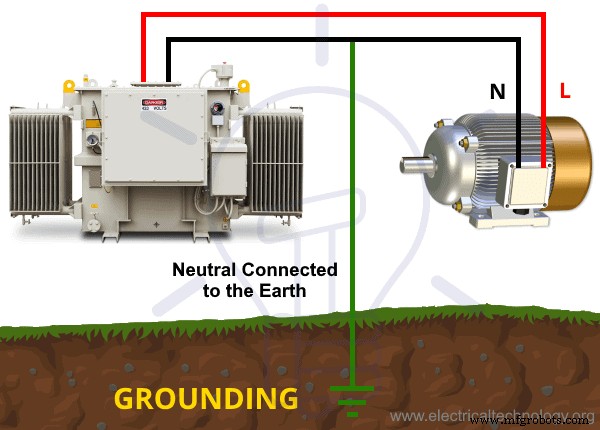
什么是接地?
接地是电器或装置的金属(导电)部件(如机身框架、正常运行时不带电的金属外壳)之间的连接和大地(地) .电气接地在美国也称为接地。
如果带电(相、火线或线路)线接触机器或面板盒外壳的金属机身框架,并且有人接触(通过触摸)机器框架或金属外壳,他会受到强烈的电击(由于地面和车身框架之间的位置较高),甚至可能由于故障电流通过受害者身体流向大地而发生触电。
为此,金属体与接地电极(或埋在地下的接地板)之间通过接地导通导体连接一根裸线或绿色或绿色带黄色条纹的导线.这样,故障电流就会向大地释放,从而保护接地系统免受危险的电击伤害。
建议在机器的外表面和金属部件与接地之间同时接地(在美国为接地),以提供额外和完美的保护。此外,电机、变压器和发电机等高压机器应接地(接地)两次,即从两个不同且独立的位置(使用单独的接地导体和接地电极板)。
接地还通过间隙、浪涌和避雷器为雷击提供了安全的放电路径,从而使系统可靠且运行平稳。
- 相关文章:零线、接地线和地球之间的区别
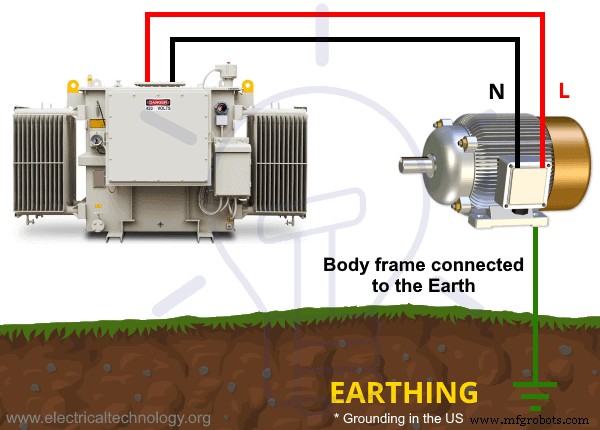
什么是绑定?
粘合或电气粘合是连接和永久连接两个电导体、机器、管道、设备和电力装置中所有金属部件的过程。 在此过程中,装置的所有死金属部件(正常情况下不带电)通过导线连接,以平衡它们之间的故意差异。
这样,即使人同时接触到不同电源的两台(粘合的)机器,他仍然受到保护(免于触电)。换言之,接合棒均衡并确保两个表面上的电势水平相同。这样就不会因为没有电位差而产生电流流动的机会,从而很好地保护了系统和人员。
由于上述原因,接地良好的连接系统用于保护人员、设备、设备和其他装置,因为接地连接系统确保所有连接的设备电压相同,因此没有机会放电和电流流动。
广泛使用接地连接以确保所有导体(人、表面和产品)处于相同的电势。当所有导体处于相同电位时,就不会发生放电。
结合确保结合的这两个东西处于相同的电位。这意味着我们不会在一台设备或两台不同设备之间积聚电力。两个键合体之间不会发生电流,因为它们具有相同的电位。
如果单个机器或面板盒正确接地(接地)并连接到另一个盒子,则由于它们之间的零(接地)电位,电流将没有机会流动保税箱或机器。
绑定本身不会保护,但会提供到电源的低阻抗返回路径。这样,就会有大量电流开始流动,从而导致保护断路器跳闸并消除故障。
绑定是必要的,因为以下两个安全相关的原因..
- 如果没有粘合,一个人同时触摸两个不同的设备(两个设备具有不同的电压等级)将充当均衡器并由于两端电位差之间的能量积聚而触电。
- 如果带电的电线接触到机器的金属机身并与人(正在操作机器的人)接触,可能会受到危险,甚至是致命的电击。
正确连接以及接地(接地)的系统可针对上述两种情况提供保护。
- 相关文章:真实地面和虚拟地面的区别?
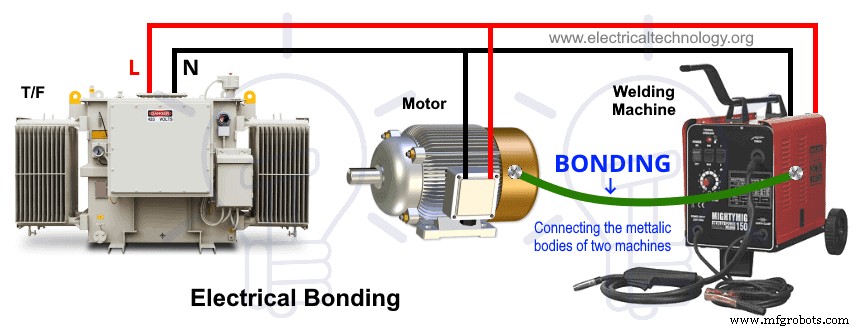
接地与接地的主要区别
接地和接地几乎是一回事,即将电气设备接地(接地板或接地电极通过导通辅助器或保护棒)。该系统在电路中提供了一个必须有参考电压,以保护设备免受雷击,并将故障电流释放到大地,从而保护生命。
对于非美国居民,地面和大地之间存在很小(几乎可以忽略不计)的差异,如下所示。
- 两个术语用于同一事物,即在美国 (NEC) 使用接地,在英国 (IEC) 使用接地,这与三路开关(在美国)和两路开关(在英国)相同而两者的用途相同。
- 接地是将故障电流排放到地面的单一低阻抗路径,而接地是双路径(有时是主电流的返回路径和多余电流的源头)。
- 当三相不平衡连接的中性点接地(以平衡系统)时,称为“接地”。另一方面,“接地”是设备/装置与大地之间的连接,用于保护设备和设备免受损坏并降低触电风险。
- 接地是电路中维持电压水平和平衡不平衡相位的公共点,而接地可保护系统免受高压浪涌的影响。
- 作为中性地线的接地用于安装系统和设备保护,而接地提供防触电保护并用作安全措施(以挽救人类/动物的生命)。
相关文章:架空输电线路中地线或地线的用途。
接地、接地和连接的比较
下表是bonding、earth、grounding的对比和区别。
| 特点 | 接地 | 接地 | 绑定 |
| 术语 | Grounding 是北美(US)中用于接地的常用词 ) 和加拿大标准,如NEC , CEC, IEEE 、ANSI 和 UL。 | Earthing 用于欧洲、共同富裕国家和英国(UK ) IS 和 IEC 等标准 等等,而接地有点不同。 | 电气连接与 NEC 和 IEC(美国和英国) 中使用的术语相同 但与接地和接地完全不同。 |
| 符号 | 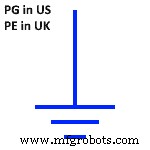 | 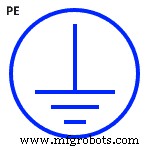 | 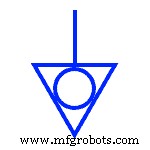 |
| 定义 | To connect the current carrying part of the electrical system to the earth electrode buried in the ground through earth continuity conductor. | To connect the metallic (conductive) parts (such as body, frame which in non current carrying during normal operation) of an electric appliance or installation to the earth (ground) is called Earthing (and / or Grounding in the US). | To connect two electrical systems (such as wires, equipment and pipes etc) together to bring them at the same potential level while they are non-current carrying during the normal operation. |
| Location of Installation | Connection between the current carrying parts of the system (such as Neutral as a return path for current) to the ground. | Connection between the metallic body frame and earth plate in the ground through earth continuity conductor &earthing lead. | Connection between two equipment, wires, pipes etc (which are non-current carrying during normal operation through a conductor. |
| Types | Solid grounding, resistance grounding and reactance grounding. | Pipe earthing, plate earthing, water main earthing, Rod earthing &stripe wire earthing. | Main bonding and supplementary bonding. |
| Wire Color Code | Green with Yellow stripe or Bare Conductor. | Green or Green with Yellow stripe or Bare conductor. | Green with Yellow stripe. |
| Path | Provides a return path to the current in case of abnormal and fault conditions. | Provides a path to a large surface to zero volt potential. | Provides a path to equalize the potential difference on two difference surceases. |
| “0” Potential | Neutral connected to ground may have some potential (zero potential where the algebraic current is zero known as “Virtual Grounding”.) | Zero Potential due to the physical connection between equipment and ground. | Same and zero electrical potential on both connected devices. |
| Protection | It protects the electrical systems and power equipment during the fault condition as it provides a return path for the phase currents. | It protects a person from hazardous electric shock as it is a preventive measure to discharge the unwanted electrical energy to the ground. | It protects equipment and personnel by reducing the current flow between two machines having different potential. the Bonding itself does not protect anything without earthing |
| Examples | Neutral point of a star connected transformer or current carrying part as neutral in the generator connected to the ground. | The metallic body frame and enclosure of the electrical machines (transformer, motors, and generators etc) connected to the earth electrode (earth plate). | Any conductor wire connected between two metallic bodies of the electrical machines &devices to equalize the potential difference on them. |
| Usage | It is used to balance the unbalanced load and protect the system. | It is used to provide protection against both electric shock and faults in the system. | It is used to trip the circuit breaker when high current flows due to existence/change in the positional difference. |
| Applications | Grounding provides an effective return path to the current between electrical equipment and power system. | Earthing draws the unwanted energy to the ground to protect the person who touches the metallic body of the machine during faults. | Bonding ensures both the connected devices at the same level of voltage and provides a low impedance path back to the source to trip the CB in case of fault currents. |
工业技术


